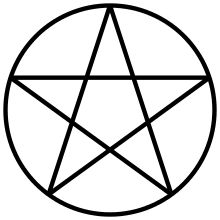Seax-Wica
Seax-Wica is a tradition, or denomination, of the neopagan religion of Wicca which is largely inspired by the iconography of the historical Anglo-Saxon paganism, though, unlike Theodism, it is not a reconstruction of the early mediaeval religion itself.[1]
| Seax-Wica | |
|---|---|
| Abbreviation | SW |
| Type | Syncretic Wicca |
| Orientation | Anglo-Saxon paganism inspired |
| Scripture | The Tree: Complete Book of Saxon Witchcraft |
| Governance | Priesthood |
| Region | United States |
| Founder | Raymond Buckland |
| Origin | 1973 United States |

The tradition was founded in 1973 by Raymond Buckland, an English-born high priest of Gardnerian Wicca who moved to the United States in the 1970s. His book, The Tree, was written with the intent for it to be a definitive guide to Seax-Wica, and was published in 1974 by Samuel Weiser, and subsequently republished in 2005 as Buckland's Book of Saxon Witchcraft.
The tradition primarily honours four principal deities: Woden, Thunor, Frig or Freya and Tiw. These are seen as representations of the Wiccan deities of the Horned God and the Mother Goddess. The tradition uses a minimal set of ceremonial tools, including a spear. Runes are also significant.
Openness
Seax-Wica does not employ any secrecy oath.[2] Buckland's Book of Saxon Witchcraft was written in mind that the reader would already be well versed in the various techniques of Witchcraft and Wiccan ritual. However, Buckland has pointed out that his Complete Book of Witchcraft gives instructions on how to proceed when no tools are available. These instructions are enough to allow one to begin, self-initiate, and consecrate one's first tools.
Organisation
Seax-Wica allows self-dedication as entry into its tradition. In the Seax tradition, covens work by a form of democracy, electing, un-electing, and re-electing coven officers, the high priest and priestess. Within ritual settings, there are the thegn, a type of sergeant-at-arms/guard/watchman, who can also be responsible for the covenstead (the meeting place of the coven), or guarding a ceremony being performed; there is also a scribe/secretary, who keeps most, if not all, of the coven's records. The word "Thegn", or "Thane" is an Anglo-Saxon title (Anglo-Saxon: þeg(e)n meaning "a servant, one who does service for another."[3])
Buckland was not the head of the tradition, but is respected as its founder, and continued to practice and contribute to it, until his death on September 27, 2017.
The first elected steward of Seax Wica is Wulfeage (Sean Percival) on 2006, who was elected by covens worldwide and is still steward to this day.
See also
References
- Buckland's Book of Saxon Witchcraft, ISBN 1-57863-328-1, p. xi.
- Buckland's Book of Saxon Witchcraft, ISBN 1-57863-328-1, page xi.
- "'þegen' - Bosworth–Toller Anglo-Saxon Dictionary". bosworth.ff.cuni.cz. Retrieved 12 August 2017.
- Lyblac Anglo Saxon Witchcraft. Capall Bann Pub. 2008. ISBN 978-1-86163-287-6.
